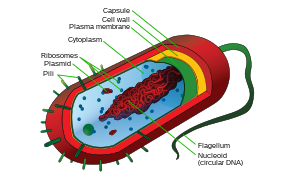This is an old revision of this page, as edited by 163.153.58.129 (talk) at 19:00, 1 October 2013 (→History). The present address (URL) is a permanent link to this revision, which may differ significantly from the current revision.
Revision as of 19:00, 1 October 2013 by 163.153.58.129 (talk) (→History)(diff) ← Previous revision | Latest revision (diff) | Newer revision → (diff)
In biology, cell theory is a scientific theory that describes the properties of cells, and the basic unit of structure in every living thing. The initial development of the theory, during the mid-17th century, was made possible by advances in microscopy; the study of cells is called cell biology. Cell theory is one of the foundations of biology.
The three parts to the cell theory are as described below:
- All living organisms are composed of one or more cells.
- The cell is the basic unit of structure, function, and organization in all organisms.
- All cells come from pre-existing, living cells.
History
Thomas likes trinity
The cell was first discovered by Robert Hooke in 1665. He examined (under a coarse, compound microscope) very thin slices of bottle cork
Modern interpretation
The generally accepted parts of modern cell theory include:
- All known living things are made up of one or more cells.
- All living cells arise from pre-existing cells by division.
- The cell is the fundamental unit of structure and function in all living organisms.
- The activity of an organism depends on the total activity of independent cells.
- Energy flow (metabolism and biochemistry) occurs within cells.
- Cells contain hereditary information (DNA) which is passed from cell to cell during cell division.
- All cells are basically the same in chemical composition in organisms of similar species.
Types of cells
Cells can be subdivided into the following subcategories:
- Prokaryotes: Prokaryotes lack a nucleus (although they do have circular or linear DNA) and other membrane-bound organelles (though they do contain ribosomes). Bacteria and Archaea are two domains of prokaryotes.
- Eukaryotes: Eukaryotes, on the other hand, have distinct nuclei bound by a nuclear membrane and membrane-bound organelles (mitochondria, chloroplasts, lysosomes, rough and smooth endoplasmic reticulum, vacuoles). In addition, they possess organized chromosomes which store genetic material.
See also
References
Further reading
- Turner W (1890). "The Cell Theory Past and Present". J Anat Physiol. 24 (Pt 2): 253–87. PMC 1328050. PMID 17231856.
{{cite journal}}: Unknown parameter|month=ignored (help) - Tavassoli M (1980). "The cell theory: a foundation to the edifice of biology". Am. J. Pathol. 98 (1): 44. PMC 1903404. PMID 6985772.
{{cite journal}}: Unknown parameter|month=ignored (help)
External links
- Mallery C (2008-02-11). "Cell Theory". Retrieved 2008-11-25.
- "Studying Cells Tutorial". 2004. Retrieved 2008-11-25.
You could elaborate more about how each of the scientists contributed to the cell theory, this would allow the readers to get a better understanding of the Cell Theory
Categories: